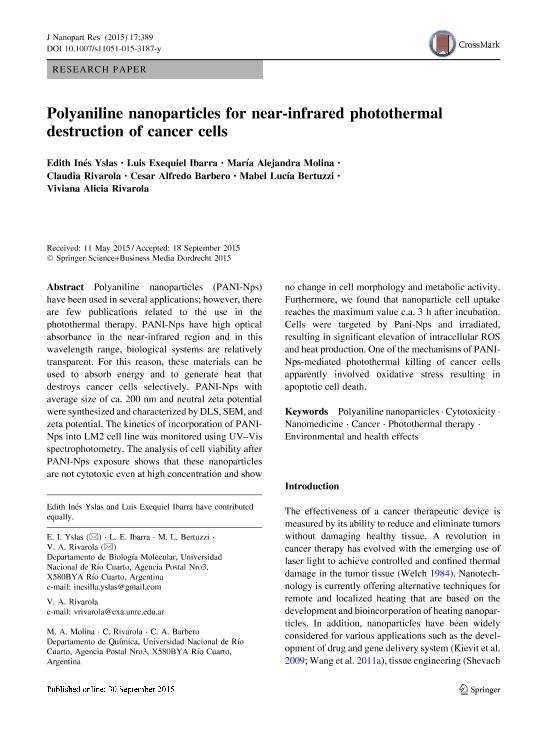Artículo
Polyaniline nanoparticles for near-infrared photothermal destruction of cancer cells
Yslas, Edith Inés ; Ibarra, Luis Exequiel
; Ibarra, Luis Exequiel ; Molina, María Alejandra
; Molina, María Alejandra ; Rivarola, Claudia Rosana
; Rivarola, Claudia Rosana ; Barbero, César Alfredo
; Barbero, César Alfredo ; Bertuzzi, Mabel Lucia; Rivarola, Viviana
; Bertuzzi, Mabel Lucia; Rivarola, Viviana
 ; Ibarra, Luis Exequiel
; Ibarra, Luis Exequiel ; Molina, María Alejandra
; Molina, María Alejandra ; Rivarola, Claudia Rosana
; Rivarola, Claudia Rosana ; Barbero, César Alfredo
; Barbero, César Alfredo ; Bertuzzi, Mabel Lucia; Rivarola, Viviana
; Bertuzzi, Mabel Lucia; Rivarola, Viviana
Fecha de publicación:
10/2015
Editorial:
Springer
Revista:
Journal of Nanoparticle Research
ISSN:
1388-0764
Idioma:
Inglés
Tipo de recurso:
Artículo publicado
Clasificación temática:
Resumen
Abstract: Polyaniline nanoparticles (PANI-Nps) have been used in several applications; however, there are few publications related to the use in the photothermal therapy. PANI-Nps have high optical absorbance in the near-infrared region and in this wavelength range, biological systems are relatively transparent. For this reason, these materials can be used to absorb energy and to generate heat that destroys cancer cells selectively. PANI-Nps with average size of ca. 200 nm and neutral zeta potential were synthesized and characterized by DLS, SEM, and zeta potential. The kinetics of incorporation of PANI-Nps into LM2 cell line was monitored using UV–Vis spectrophotometry. The analysis of cell viability after PANI-Nps exposure shows that these nanoparticles are not cytotoxic even at high concentration and show no change in cell morphology and metabolic activity. Furthermore, we found that nanoparticle cell uptake reaches the maximum value c.a. 3 h after incubation. Cells were targeted by Pani-Nps and irradiated, resulting in significant elevation of intracellular ROS and heat production. One of the mechanisms of PANI-Nps-mediated photothermal killing of cancer cells apparently involved oxidative stress resulting in apoptotic cell death. Graphical Abstract: [Figure not available: see fulltext.]
Archivos asociados
Licencia
Identificadores
Colecciones
Articulos(CCT - CORDOBA)
Articulos de CTRO.CIENTIFICO TECNOL.CONICET - CORDOBA
Articulos de CTRO.CIENTIFICO TECNOL.CONICET - CORDOBA
Citación
Yslas, Edith Inés; Ibarra, Luis Exequiel; Molina, María Alejandra; Rivarola, Claudia Rosana; Barbero, César Alfredo; et al.; Polyaniline nanoparticles for near-infrared photothermal destruction of cancer cells; Springer; Journal of Nanoparticle Research; 17; 10; 10-2015; 1-15
Compartir
Altmétricas



